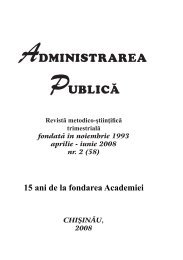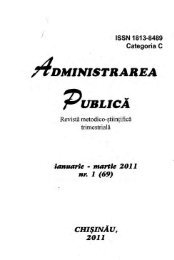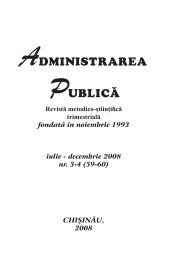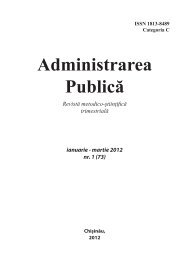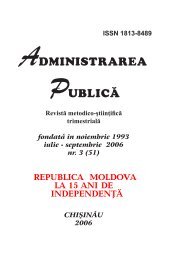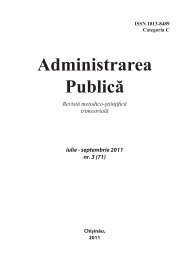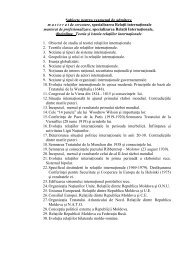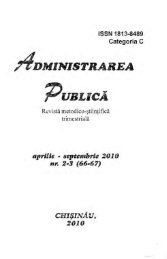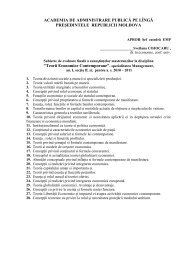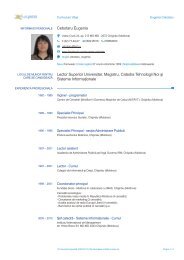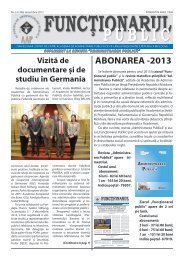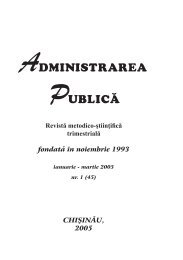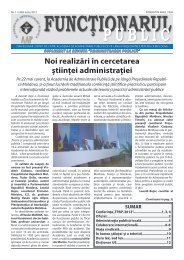Revista "Administrarea publicÄ" ianuarie â martie 2010 nr. 1
Revista "Administrarea publicÄ" ianuarie â martie 2010 nr. 1
Revista "Administrarea publicÄ" ianuarie â martie 2010 nr. 1
You also want an ePaper? Increase the reach of your titles
YUMPU automatically turns print PDFs into web optimized ePapers that Google loves.
sional development plans inel ude key topics<br />
of training courses and the public authorities<br />
that will be involved in the development<br />
and implementation of training programs.<br />
Therefore, the drafting of training<br />
curricula is based, primarily, on the topics<br />
included in the plan, which allows focusing<br />
on the task of meeting the trainingneeds<br />
identified by the central and local public<br />
administration authorities. The involvement<br />
of specialists from public authorities in the<br />
development of training curricula for slate<br />
financed courses will make the training<br />
innovative and practical.<br />
Courses for individuals newly employed<br />
in civil service were also planned for the<br />
first time. Therefore, in 2009 initial training<br />
courses are planned for 200 junior civil<br />
servants, employed for the first lime in<br />
public administration authorities. To ensure<br />
their training during the probation period,<br />
such courses are scheduled each three<br />
months.<br />
To meet the training needs of civil servants,<br />
additionally to the state financed<br />
training, a contract for provision of training<br />
services was signed with the APA.<br />
Consequently, 69 professional development<br />
courses were conducted during 2007-2009<br />
and attended by 1442 civil servants.<br />
The efforts made to implement the training<br />
curricula resulted in a substantive devclopmcntof<br />
civil servants' skills.Therefore,<br />
of all the civil servants from the central<br />
offices of specialized central bodies<br />
of the Executive about 70% received training<br />
in 2007,78% in 2008 and 74% in 2009.<br />
In this period, about half of the civil servants<br />
from the central offices of central<br />
public administration authorities received<br />
at least 40 hours or 5 days of training (according<br />
to the requirements set in the<br />
normative framework).<br />
Efforts were also made to organize<br />
English language courses for the civil servants<br />
from the Government Office and<br />
central specialized bodias with the support<br />
of the Trust Fund for CPA reform. The<br />
English language courses had two stages<br />
(120 hours each). The curricula of English<br />
language courses were adjusted to<br />
different levels: beginner, intermediary and<br />
advanced.<br />
Consequently, 364 civil servants from<br />
ministries and other central administrative<br />
authorities attended the first cycle of the<br />
English language courses and 550 the second<br />
one.<br />
Chart 1 shows the percentage of civil<br />
servants from the central offices of central<br />
public administration authorities trained<br />
in 2008, classified by financing sources.<br />
Proce<br />
Improvement of Personnel<br />
dures<br />
i<br />
3<br />
3<br />
5Г<br />
з<br />
г<br />
с<br />
о'<br />
i<br />
о<br />
1<br />
(5"<br />
40<br />
17<br />
Chart iio.l. Hnanung sources for civil ser mtsiteitupg, айв %<br />
П Internal Training<br />
• Trust Fund Support, lingiisri<br />
Language Courses<br />
• Trust Tund Support. АРД<br />
• Other Donors' Assistance<br />
• Slate Order, APA



